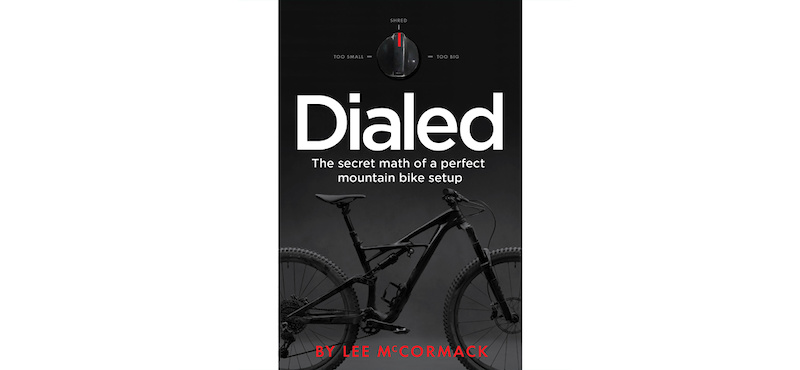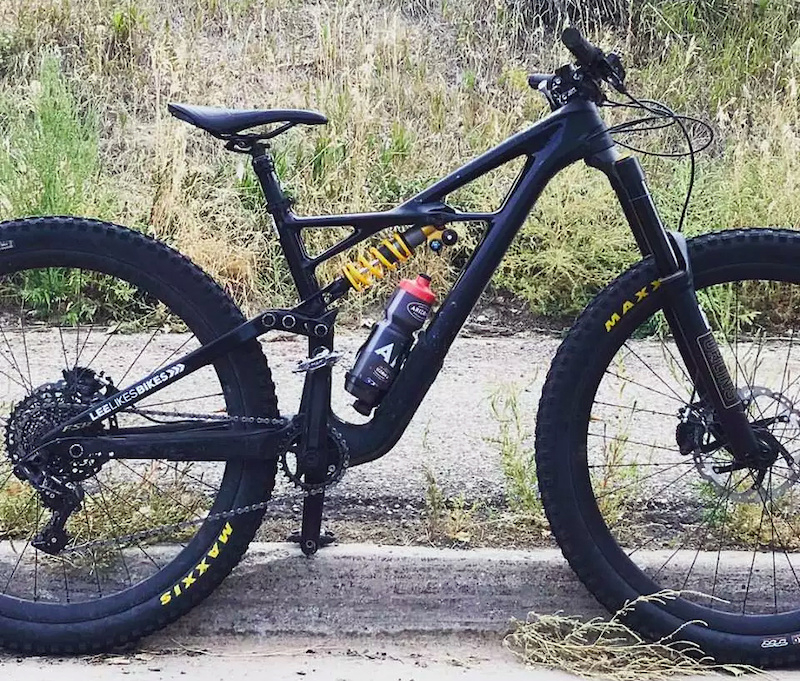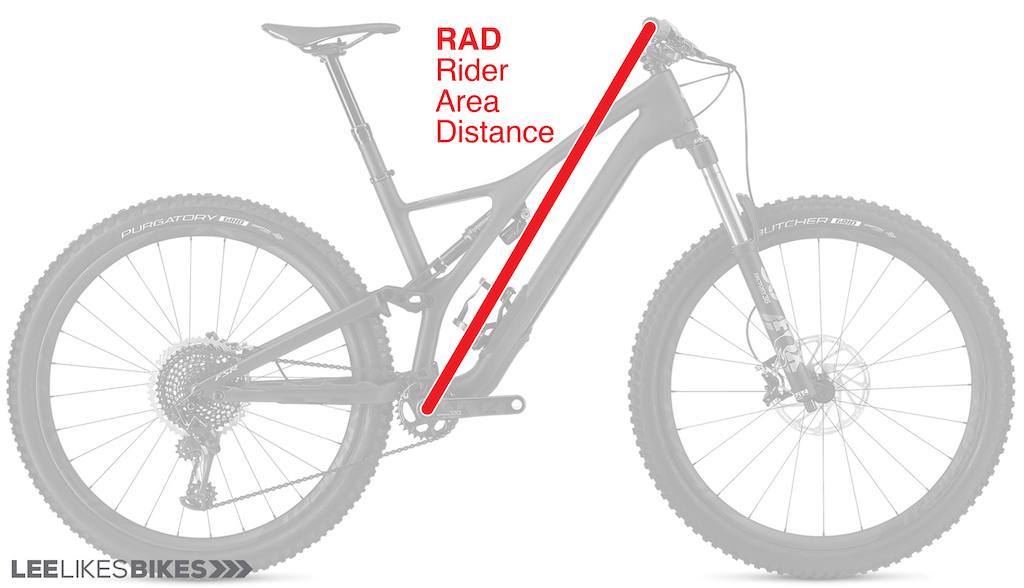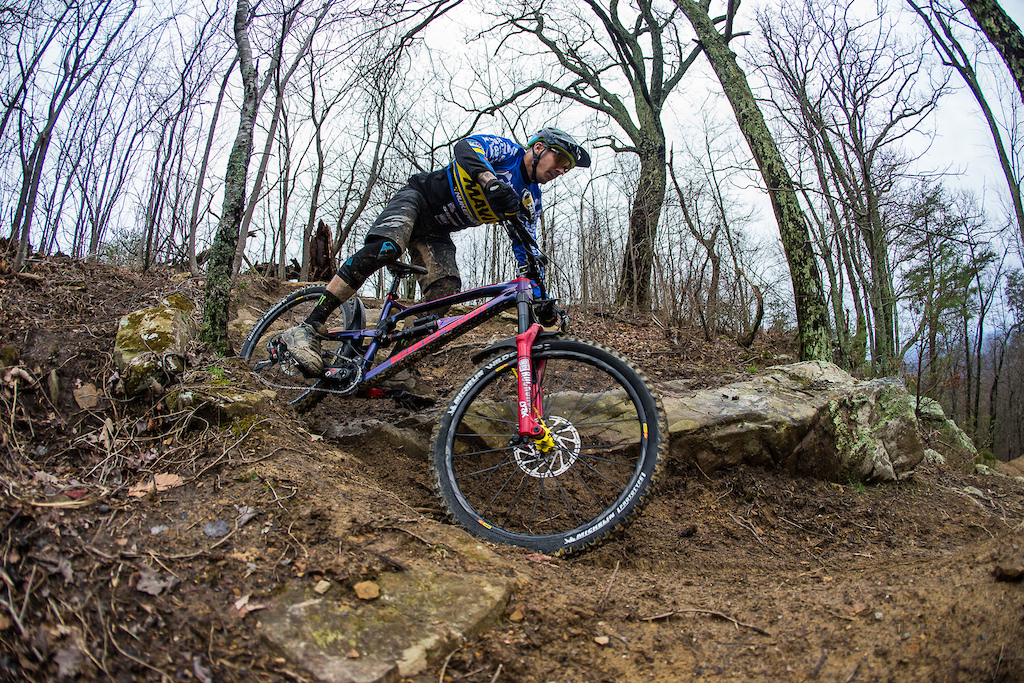Lee McCormack's Guide to Bike Set-Up
When it comes to mountain bike setup, the most important measurement is the distance between your bottom bracket and your grips. I call this the Rider Area Distance (RAD).
We want your bike RAD to fit your body’s size and proportions. When your RAD is dialed, two great things happen:
1. You have optimal arm range for bike handling: descending, braking, cornering, pumping, dropping and all the fun stuff, and
2. You can generate maximum torque for power moves: sprinting, steep climbing, pumping, manualing, hopping and wheelie drops.
While RAD seemed like my own brilliant idea, other people have been thinking this way.
In this video post on Pinkbike, the crew at Vorsprung Suspension calls RAD “spread.”
That’s pretty rad.
What exactly is RAD?
RAD is the hypotenuse of a triangle whose other two sides are the reach and stack of your entire cockpit, from the bottom bracket to your grips.
The components of RAD are:
• Frame reach
• Frame stack
• Height of spacers under your stem
• Tallness of your stem’s steerer clamp
• Handlebar rise
• Handlebar setback. This is probably a new term for you. Setback is the horizontal distance from the stem clamp to the grip. Someday we’ll all know the setbacks of our handlebars.
Finding your ideal bike RAD
Your ideal bike RAD is determined by your body’s size and proportions, as well as your handlebar width, crank length, pedal thickness, shoe thickness, phase of the moon and, by extension, the grunion run.
My book Dialed and site www.llbmtb.com provide several ways to determine your optimal RAD and calculate your ideal bike setup.

Dialed: The secret math of the perfect mountain bike setup.
Here are two more methods:
1. If you love your current bike, measure its RAD. When you shop for a new bike, try to match that number.
2. Use a simple multiplier. The multipliers below assume average proportions, sweet spot handlebar width, height-appropriate crank length, and average pedal and shoe thickness. While these recommendations are not gospel, they are good starting points for most people.
If you’re male, multiply your height in centimeters by 4.47
If you’re female, multiply your height in centimeters by 4.60
At 174 cm tall I get a RAD of 778mm. My bikes are within a few millimeters of this number.
Warning: These multipliers will give you shorter RADs than you typically find on fashionable bikes. Bikes have gotten longer but people haven’t.
Adjusting your RAD
Q: How close to perfect does RAD have to be?
A: The closer the better.
We can of course ride a wide range of bike setups (we’ve been doing it for years). As your bike RAD gets closer to ideal for you, your bike will start to feel better. When you get to the last 10mm, then the last 5mm, then to perfect, something clicks. Your bike just feels right. You climb technical trails easier and shred technical downhills harder.
When bike RAD is too long, you reduce torque and reduce control. I've set up about 1,000 riders, and 95% of their bikes had too much RAD. Most riders don't know any better.
When bike RAD is too short, you reduce torque and increase control (to a point). Some downhill and freestyle riders, who need more range of motion than peak sprint power, have RADs that are “too short.” This is common among tall riders. When it comes to RAD, a bit too short is much better than a bit too long.
You can adjust your bike’s RAD in a few ways:
Reach. Change the stem length or use a handlebar with different setback.

When Specialized sent me a medium 2017 Enduro Öhlins Coil (thank you!), it was 20mm longer than my last medium bike. A SQLab 30X handlebar has extra backsweep and setback, which shortens the cockpit and makes the bike fit perfectly.
Stack. Move spacers above or below your stem. Change to a stem with different rise. Try a handlebar with different rise.
Frame size. This is the last resort. These days, as frame reaches get longer, many riders should consider a smaller size. By the way, it makes sense to measure before you buy.
If your frame is the correct size and your RAD is perfect, your bike will handle great.
That said, you can dial in your bike even more by adjusting the angle of your RAD relative to level. I call this your Rider Area Angle in Degrees (RAAD). We’ll talk about that next time.
I hope this is helpful.
Lee
- - - - - - - - - - - - - - - - - - - - - -
I’m Lee, and I Like Bikes. Over the years I’ve written 10 mountain bike books, built a bunch of pump tracks, taught thousands of riders, invented RipRow and devised the RideLogic bike setup system. Thanks to the knowledge I’ve discovered for the mountain bike community, I’m riding better — and having more fun — than ever.
Learn more at
www.leelikesbikes.com
www.llbmtb.com
www.riprow.com
Author Info:
Must Read This Week
Sign Up for the Pinkbike Newsletter - All the Biggest, Most Interesting Stories in your Inbox
PB Newsletter Signup




 Member since Jan 1, 2000
Member since Jan 1, 2000
You could ride a unicycle on your tip toes with the correct "RAD" otherwise. Maybe that is the new trend - high - short - steep? the new DOWNCOUNTRY.....................
Sure given that you are running a fork with relatively close dimensions and wheel size that will make it close - you need an angle...............
One could comment that "it could be an penny farthing or an aero road bike" but it won't be will it? Not if you're buying a mountain bike at least. Personally I try to set my bikes up so I get good back extension and can recruit my upper body when I sprint. That means I set my road bike up with a very similar bb to grips measurement to my mountain bike.
Ffs!
I bought the book, it's really good. I'm recommending it to my LBS, who does more roadie stuff than MTB.
"That said, you can dial in your bike even more by adjusting the angle of your RAD relative to level. I call this your Rider Area Angle in Degrees (RAAD). We’ll talk about that next time."
I can’t speak for everyone but please keep it up and pls ignore me
I call bullshit on the bar widthmagic, and this will go right along with it.
The article about handlebars made it pretty clear the measurements were simply a guide based on an ideal size for average proportions. He specifically addressed taller riders and said they would likely need to go smaller and listed some benefits of using a smaller bar for everyone.
Don’t get me wrong, the size is a major factor but is almost secondarily relatable to the shape of the bike for me.
Perhaps I just over think everything? But that’s surely not true
And to be fair, bringing it back to the points you made the biggest changes in this angle have often (not always) been when moving from a trail bike, to enduro, to downhill or vice versa. Within the same categories there can be assumptions made about similarities I suppose
Whereas you're setting yours up to manual. Interesting. In that case, I can understand why your angle from bb to bar would be more important. For me, that angle is less important. I still love to manual, but I am trying to get the most power I can from my body.
Nice job on this book @leelikesbikes I've recommended it to many people I teach and in the industry.
www.pinkbike.com/u/leelikesbikes/blog/dialing-in-your-bike-for-your-riding-style.html
Is it too much to ask that you identify upfront whether content is PB created, PB advertorial, paid advertorial or just plain advertising? This way I wouldn't be wondering what the heck I was reading and why I was reading it...such as in not very clear but clearly product phishing articles like this one.
There might be something to this but this article explores the uncanny valley between content and clickbait far too much for my liking...
Kind regards
Me
Back in the day, content was content and ads were ads. In the newspaper where I worked, there was no contact between the editorial people and the ad people. It wasn’t allowed.
Writers/photographers/artists were paid to create content. Since they were being paid for their work, they were able to report the news or express views without needing to include commercial messages.
These days, content is disposable and generally not paid for. I get the sense Pinkbike is doing well financially, but having to pay professional rates for all of their content would be prohibitive.
Given Pinkbike’s reach, I’d expect at least $1 per word plus more for art, so this post would cost Pinkbike $1,500 to $2,000. When I write for Bicyling Magazine, for example, I get paid for the content, and there is no commercial message.
So on sites like this you have people like me (and all the bike companies) who are willing to create content, with the agreement that we can further our financial agenda. The smart content creators provide tons of value, so plenty of people enjoy the content and get exposed to the message. Example: Commencal makes some great videos! I know they’re selling bikes, but that’s OK because they’re giving me some stoke. That’s the tradeoff.
If people don’t want their content mixed with commercial messages, they can always pay subscription fees. $100 per year to read Pinkbike. All content creators get paid. Ads are ads. I don’t see that happening unless society crumbles and we rebuild anew.
In other news..."unless society crumbles and we rebuild anew."...you say that like it isn't already happening, full speed ahead
I understand roughly how PB works and indeed where most of its content comes from... especially the company edits.
However, in the case of an article such as yours...it's not quite so clear. A large chunk of user generated content here is travel logs and local event roundups - mostly nothing that's overtly commercial in aim. Yours is clearly not one of these.
And yet it's one of those technique/setup/ride skills posts that a site like this sorely needs on a routine basis in order for riders to develop knowledge and understanding of riding that they can use to improve their skills on the bike.
My issue with this particular piece of content was that, as written, the aim of the piece wasn't clear from the get go. Was it a gift of content? Was it a teaser for a commercial product? Was it shameless self promotion? Or was it a mix of all three? Ultimately, these are rhetorical questions.
My preference for PBs user generated content would be for both PB and the content creator to be up front and honest about their content and why they are sharing it with the PB community...and what they'd like in return...be it clicks, kudos or coin.
What a bunch of jibberish. While I do think the addition of spread to the geometry sheet makes sense, isolated it’s simply not enough. Just taking things like weight distribution in as well as different riding styles. Personally I like short bikes cause they manual easy. Also I like long bikes because they’re mine stable descenders. But hey, he wrote 10 books, so he probably knows better.
Even the leverages front to rear, are actually similar.
Same here....I tried the new super slack and super long bikes (not a Pole though) and didn’t come to terms with them. When I was riding downhills all day long I found it more and more difficult to put enough weight on the front wheel....when I was getting tired I had just too many washouts ....these bikes may work for some but not for me...
And my bike is 2mm out.
Well, the only thing I have to say about that is....rad?.
To me the dude is worth listening and trying out his recommendations.
Btw, the measurements from 4.47 are pretty close to what I have on my current bikes. And the prior handlebar ROM article was pretty close too.
"light hands heavy feet" I'll never forget this
- Me, 2018
Reach without stack doesn’t really mean a lot....
I've just bought an XXL Transition Sentinel with a reach of 515mm so that means by stack has to become 704mm.
Anyone know if you can buy a 300mm dropper yet?
What am I not understanding here?
1) a shorter stem, which is almost always the easiest, cheapest and best solution. I'm not sure what you mean by " it lines up perfectly over my fork offset."
2) a lower handlebar.
Or bikes have been too short for years.. anyone who's ridden off-road motorcycles will know mountain bikes have always been too short.
No doubt there's some truth in what is being said here but it feels like this won't give you the right bike for your riding but a bike that at least fits you.
If I have a long bike with short chainstays it will ride somewhat awkward because Im so far back and cant apply enough pressure.
Theres a point why Specialized went longer chainstays with their new Stumpi Evo (as Pole, Propain already did).
Im Not the biggest Specialized fan but nearely all of their bikes are spot on- the Stumpjumper Evo especially.
Mandy, many will follow I bet
Happy now?
My measured "RAD" falls within 10mm using the formula and I'm built like a skinny twisted beef jerky with long arms and legs.
Lee also has a sense of humor in addition to MTB skills that most of us can't approach. Please read his caveat in the above article again: "Your ideal bike RAD is determined by your body’s size and proportions, as well as your handlebar width, crank length, pedal thickness, shoe thickness, phase of the moon and, by extension, the grunion run." :-)
Ride on!
For example:
Frame 1:
Reach: 460
Stack: 590
HA: 70
Frame 2:
Reach: 441
Stack: 645
HA: 67
Frame 1 looks longer, but let's dig into that. Say I want a stack of 665. I'd plug that number into this:
Adjusted Reach = Reach - (Desired Stack - Actual Stack)/TAN(RADIANS(Head Angle))
Frame 1 has an adjusted reach of 433.
Frame 2 has an adjusted reach of 433.
Despite a 19mm difference in frame reach, these bikes will have an identical fit when I bring the bars up.
(Desired Stack - Actual Stack) gives you the vertical distance you're adjusting for.
Dividing by the tangent of the Head Angle translates that vertical distance into a horizontal distance.
"Radians" converts degrees to radians; it's only there because I pulled this formula from a spreadsheet. You'll want it with Google Sheets or Excel.
The next step is to consider the stem length the frame is suited to use. The 80mm on my steep XC bike would be a rudder on a slack trail bike. If I wanted to run 40mm instead with the same bar on a new trail frame, I'd need that frame to have an adjusted reach 4cm longer.
(Quick digression: this assumes the stem body is horizontal when mounted. If your stem angles up or down when mounted, your effective stem length isn't what's printed on the stem. Stems are measured on their longest axis, not the horizontal; a +30D 60mm stem will be significantly shorter than a 60mm -17D stem. This will affect how the bike steers.)
=460-(665-590)/TAN(RADIANS(70))
Spacer Depth = (Desired Stack - Actual Stack) / SIN(RADIANS(Head Angle))
I for one am so grateful that someone boiled all the geo numbers into something that actually makes sense. The distance from feet to hands plus the angle of that relationship is OBVIOUSLY (in hindsight) the central factor in bike fit, and whether or not I wind up on the number suggested by Lee's formula it's the first paradigm I've seen that I can begin fitting my experiences into to understand what I'm really looking for.
Anyway. @leelikesbikes: When buying a bike, I assume the frame RAD should be somewhat shorter than your target bike RAD to accommodate stem length and bar rise. About how much should this difference be? What is the range of adjustment before you start compromising things like weight distribution and SHO?
1. Seat tube angle and inseam will determine your seating location.
2. Bar width will determine your back angle.
So you could fit very differently on two bikes with same RAD.
"Shouldn’t we be measuring bikes in a different way? For instance from pedals to grips?"...No! That doesn't tell you if the frame fits or suits your needs. You could have custom bars made for any bike to get you hands back in the same position. I could take a tiny kids bike and build some bars that are super tall and have an initial forward sweep and get my hands in the same position as on my XL bikes.
So if I don’t like stems longer than 50mm for handling and don’t what a bunch of spacers under the stem (since that starts to shorten reach) what size bike do I look at? I don’t think RAD/Spread on its own is enough but it may be more valuable than just reach or stack when looking a numbers and trying to figure out which bike and size to try.
Its a a fine tuning that composes of stem, headset spacers and handle bar back sweep. Since front triangle is non adjustable and this is one way to fine tune your Bb length to ideal reach of stem.
I started with 50mm reach stem, then 45mm, 40mm and finally 35mm and Baaaaammmm!! Finally an ideal set up base on my riding preference. I tried 30mm reach for the stem just to see how it feel and its short. I ended up with 35mm stem. And I still have to Fine tune my handle bar back sweep. I have the 10 degree back sweep and I can feel the different , its a little short and I ended up 9 degree back sweep and I think its hit the spot.
I have been recommending this set up with my bike buddies everytime I was asked for an Ideal bike set up.
Being short torso/ long legs person, seat tube angle for me quite important since seaddle rised far above the stem even with lovered dropper post, and that's move my weight over back wheel
My bikes measure 903 and 915 from the outside back edge of the grip to the center of the BB/crank hole. Using your formula that means it is right for someone 6’7”. I am 6’4” (with longer legs and shorter torso).
The 903 bike feels a little short when riding and the 910 bike abiut perfect. Also. When I do the picnic table test the 903 bike is abiut 5-10 mm short and the 915 abiut perfect.
Either I’m measuring wrong, have very weird proportions, or the formula doesn’t work well for tall people.
As an MXer, when I first began riding mountain bikes about 5 years back, the awkwardness of MTBs took me by surprise, but I adapted in time.
UNTIL I went to AF Bike Park on a couple of pretty modern Enduro style bikes and when I went to stand up for long periods of time, I truly realized how much geo on modern MTBs was just, terrible. Really bad. The Reach was so short that if you stood in a balanced position, your knees were literally mere inches from your knees. If you leaned way back to try and correct, your weight wasn't centered, the bike handled poorly, and my legs were shot within half a day from holding myself in an awkward position.
I don't doubt that those above RAD dimensions result in efficient pedaling. I also don't doubt that some much more talented rider can go right down this roughest of steeps with his weight well forward of his front contact patch. I can't.
I am MUCH FASTER and SAFER on a much longer bike. I also climb and turn better.
Add 4"+ to that RAD dimension imo.
But giving out a single riders height to RAD conversion factor (and sorry, of course a different for women) seem a little bit too simple...
What about a RAD-angle?
And to TK ...the conversion from cm to mm is part of the magic of the 4.47 factor ????
I may be the odd one here to define a geometry parameter relative to the (mean) horizon instead of to something fixed with respect to the bike. Then again the geometry of an unsprung bike doesn't tell me much either (right down to the chainstay length of a typical full suspension bike) and I found setting sag on a slope works better for me too. So at least I'm somewhat consistent
Yeah this isn't making much sense to me either. Apparently my "RAD" is about 15mm too big. That means I should take my two stem spacers under the stem and put them on top, reducing my RAD but increasing my reach? Would that not DECREASE the amount of torque I could apply, plus make my arms have to reach even further?
There's a lot of subtlety to bike geo but there is definitely something to this.
My legs are also long for my height so I end up looking scrunched up on a bike that perfectly fit mates the same height.
If the bars were Forward or Below the pocket, it felt too big.
Behind or Above, and it felt cramped.
Also noted the measured wheel weight distribution front to rear of each.
60/40 seemed the best for XC. 65/35 the best for descending....
One point I wanted to make is about bikes with adjustable geometry having the ability to change their bottom bracket heights. Another method of altering the RAD. I find my bike surprisingly more stable with the stem slammed and the Geo in the high position. My frame has 430mm reach and I am 167cm riding an Orbea Rallon.
The above comment is an understatement. Am 6'1" and I ride a L Sentinel. Measurement was 80mm too long. So do I need to get a S frame with 25mm stem and 620 mm bars?
BETTER YET, BUY LEE'S "DIALED" AND GET IT RIGHT FROM THE START!
Hope that helps.....ride on!
--> We can of course ride a wide variety of setups. This system has proven to work well for me, the people I work with in person, and the members of my online MTB school.
Proper in-saddle fit is the most important, regardless of downhill performance, simply due to the time and energy spent in it. Period.
I like the idea of a RAD figure on frame specs.
Personally, I prefer to use reach and chainstay length added together. This give me a better idea where I am in the bike and whether I can get my arse over the back axle.
If you’re male, multiply your height in centimeters by 4.47
If you’re female, multiply your height in centimeters by 4.60
As for the RipRow, maybe you should try one before you call it junk. As far as anyone being a tool, the only tool here is knowledge, either learn or move on to another article, its simple...
Thanks!
1) Pushups only use pushing strength.
2) Great riding uses a lot of pulling. The more advanced you are, the more pulling you do.
3) Maximum pulling strength happens at a narrower hand width than pushing.
4) We need a compromise of pushing and pulling strength. Hence my new approach and the new method of determining bar width.
I hope that’s helpful.
Second, you really need an effective maximum on your bar width suggestions. At 6'3" the bar width suggested is already way too wide for anything but flow trails. Add in the fact that I have broader than average shoulders and long arms and the width has to get ridiculous. That's where you are losing some people because of the huge numbers they are seeing just don't make sense in real world riding, even if they are biomechancialy optimal.
Finally, the modern world has gotten sensitive to lure and pay wall marketing. Perhaps instead of overtly shilling your paid content you should make the basic calculators, for the information you provided here, free. That way you get people to your site and the desire to pay happens organically. Just some unsolicited advice.
As for paying for it, why would I do that? I think more inline with the likes of Chris Porter. Physics agrees with that design philosophy more. True, your numbers may be optimal biomechancialy. However, I believe they ignore several other factors that contribute to the overall riding experience.
That's what she said.
And at 186cm (6' 1") it gives me 826mm bars!! I want to actually fit down the trail when I ride my bike.
I know the idea is to sell a book. Must be a slow news day.
At 5'11" on a 35mm stem and the seat slid forward a bit I find my Foxy 29 Reach of 490mm just a wee short. 500mm would be ideal for me and then I could drop to a 30mm stem as well.